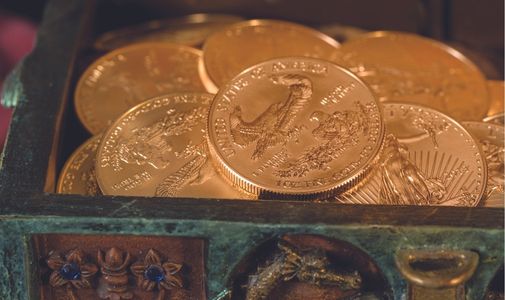I was expecting to get ripped off.
I mean, one does not wander into a bazaar anywhere in the world pre-supposing a fair price…at least not without some earnest haggling, a bit of scoffing, some faux exasperation, and pretending to walk away in search of a better deal elsewhere.
Which is what I was prepared to do as I asked the gold merchant, “How much?” for a 22-karat gold necklace and some 22-karat gold earrings I was buying as a surprise for my wife.
I’d done a bit of research on gold prices before I left my hotel, so I knew how much grams of gold were selling for on global markets. I was hoping to settle on a price within about 10% of the spot price.
Well, it turns out the gold dealer in the ancient Muttrah Souk, located in Oman’s capital city Muscat, offered me a price right at the outset that was just a few percentage points above that day’s gold price. His price was cheaper than anything I could have found online through any of the gold sites I normally buy from.
How are you supposed to haggle with a price like that? So, I paid the man and walked away a happy customer.
I’ve made a habit of walking into gold shops wherever I happen to be traveling, looking for items to add to my collection, whether that’s interesting jewelry or local coins from centuries past.
The reason I do so is a matter of increasing urgency: I am convinced that Western governments are barreling toward a currency crisis later this decade due to their massive, ever-increasing levels of debt. And that crisis could very well be centered on the U.S. dollar.
The dollar is the world’s reserve currency. That means that the vast majority of global trade, whether that’s Japan selling TVs to Brazil, or Uruguay selling soybeans to China, is priced in dollars. This creates strong demand for the U.S. dollar, which keeps the price of the dollar high. This benefits us as American consumers. It makes our imports cheaper and grants us significant control over the global economy.
Gold can be romantic and financially prudent.
The greenback is about 78 years into its rein as monetary king. And it will certainly hold the title for a few years more. But the magnitude of Uncle Sam’s debt—$31 trillion, an unmanageable 123% of GDP—guarantees the dollar’s days are numbered. The worsening political divide in America will speed up that demise.
That may sound alarmist, but when you look across the span of history, not one single reserve currency has survived… going back to 15th-century Portuguese real. Literally not one. Every currency the world has ever considered a “reserve,” ultimately lost its crown.
Which is part of the reason I was in that Omani gold souk: I wanted to add another bit of hard-asset wealth to what I consider my “lifestyle insurance policy”—gold. Granted, that’s not as loving as “a gift for my wife,” but buying gold can be both romantic and financially prudent all at the same time.
In every monetary crisis stretching across human history, physical gold has played a role in the solution. There’s no reason to believe that it will be different this time.
Sure, you’ll hear U.S. government bureaucrats and ivory tower types pan gold as an archaic economic relic. But that’s just modern arrogance, and it flies in the face of one crucial fact: Central banks and governments all over the world own an estimated 35,000 tons of gold, 20% of all the gold ever mined. And they’ve been adding to their individual hordes over the last decade—a combined 4,500 tons.
Their rationale for doing so is best summed up by the Hungarian central bank, which earlier this year tripled its gold holdings to 94.5 tons. It noted: “The appearance of global spikes in government debts or inflation concerns further increase the importance of gold in national strategy as a safe-haven asset and as a store of value.”
The way I see it, if governments own gold to protect their wealth against inflation and Western debt, then I should own gold too.
Which brings us to the question: What are the best ways to own gold? And where should you buy it?
The Best Ways to Own Gold
First and foremost, I have zero interest in owning gold through an exchange-traded fund such as the SPDR Gold Shares, the largest gold ETF, known simply by its ticker symbol GLD. GLD’s big flaw—and it’s a huge red flag—is that GLD investors do not own gold. They own a paper claim on GLD’s assets. That’s problematic because GLD’s gold is loaned out and borrowed. And the loaned/borrowed gold is, in turn, loaned and borrowed further.
In a crisis, the daisy chain of lending and borrowing through custodial banks and sub-custodians could collapse. As a GLD holder, you would not be entitled to the physical quantity of gold you think you own. You’d be a creditor who’s owed some amount of dollars, and that amount would likely take a significant haircut because of the losses.
So, I want to own physical gold. That way, I am certain that my gold is, in fact, my gold.
Unlike GLD, some funds do own physical bars of gold that are held in vaults and audited regularly.
To that end, there’s Sprott Physical Gold Trust (symbol: PHYS), which trades on the New York Stock Exchange. Sprott physically owns fully allocated and unencumbered gold, meaning the gold sits in a vault owned and operated by the Royal Canadian Mint, and allocated in the name of each shareholder. Moreover, that gold is never loaned to others or borrowed from others.
Basically, gold exposure through Sprott is as close to physical ownership as you can get without actually taking control of your gold directly. And if you want, you can take ownership through Sprott. Those who own the equivalent of a bar of gold can actually have the physical gold delivered to their address by armored carrier, if they wish.
Beyond Sprott, there are other options including unallocated gold accounts. The U.K. government’s Royal Mint offers a service called DigiGold (see: royalmint. com/digital-investments/digigold/digi-gold) through which you can buy gold for as little as £25 (about $30). The mint holds the gold for you in a pooled account with other buyers. You cannot claim the gold itself, but you could cash it in and buy gold sovereign British coins.
The benefit of this account is that the fees are quite small, just 0.33% to buy, 1% to sell, and 0.5% value added tax. If you try to buy quantities of gold through coin shops and gold dealers, you’re going to pay markups of 30% or more, depending on the amount of gold you purchase. With the Royal Mint, almost all of your money goes into gold rather than the fees.
Similar programs exist through metals dealers all over the world.
I have an account, for instance, at BullionStar.com (see: bullionstar.com) in Singapore. There, you can buy everything from gold bars and rare coins, to bullion jewelry such as 24-karat necklaces and gold rings. Better yet, BullionStar will store all of your metal for you, then send you photographic evidence of it along with a vault certificate detailing your holdings. It’s a great way to hold gold offshore in your name and at minimal cost.
Owning physical gold ensures it’s, in fact, my gold.
You have U.S.-based options, too, if you want your gold nearer to you. Schiffgold (see: schiffgold.com), JMBullion (see: jmbullion.com), and Apmex (see: apmex.com) are just some. They all offer gold storage services for a fee and they’re all reputable.
Owning Physical Gold
If you want to take physical control of your gold, you have three primary options: high-karat gold jewelry, bullion bars/coins, and numismatic coins that once served as legal tender in global trade. Each has its pros and cons.
Jewelry: Depending on where you buy it, you’re quite likely to pay well over the price of the underlying gold, since there are fabrication costs to consider. So I would avoid traditional jewelry stores, particularly in the U.S., where overheads are high.
That said, if you find yourself in the Middle East, in a place like Dubai or Muscat, Oman, the local souks and bazaars are known for their abundance of gold dealers. These dealers sell high-quality gold to some of the world’s most-demanding gold buyers from across the region and India. And they offer some of the best prices I’ve ever seen.
Bullion coins/bars: Numerous countries sell bullion coins, such as the American Gold Eagle or Canadian Maple Leaf. Or you can find generic bars and “rounds” from producers such as PAMP Suisse, Credit Suisse, and Valcambi. These are fine to own, and both generally carry the smallest markup, about 5%, though some that are in high demand, such as the Gold Eagles, are often marked up by as much as 10%. The dealers I use for these are Apmex.com and BostonBullion.com (I have no affiliation with either).
The risk here is that this is bullion, and if the federal government ever decided to confiscate gold again, as it did in 1933, to deal with a financial or monetary crisis, the generic coins and rounds would fall under that order.
Sovereign coins like the American Eagle likely would too, unless they were officially graded and sealed in plastic collector sleeves, at which point they become…
Numismatic collectibles: These are rare and collectible coins. Some of them are graded and are in those plastic sleeves I mentioned, but many are not. Still they are considered collectible because of their age.
Numismatic coins (jewelry also) were exempt under the 1933 confiscation order, and likely would be again because numismatic coins are worth more than the price of gold for various reasons, such as their rarity and historical significance. Confiscating them would lead to an untold number of lawsuits against Uncle Sam.
Rare coins tend to be where I do most of my buying. You will often pay a larger markup, sometimes much larger, depending on rarity. But if you buy pre-1933 gold coins such as the so-called Liberty Head Gold Double Eagles, or the St. Gaudens Gold Double Eagle in a lower quality condition, you can find them at 7% to 10% markup, which is little different than buying regular bullion, only with a reduced risk of confiscation. Both coins are nearly one ounce of gold.
Rely on trusted dealers such as Apmex, BostonBullion, and JMBullion when buying these. Avoid eBay, where you will very likely overpay.
 Jeff D. Opdyke is the editor of The Global Intelligence Letter, IL’s guide to personal finance. Based in Prague, he spent 17 years at The Wall Street Journal and today writes about international investing and lifestyle for IL. Check out his free e-letter, Field Notes at IntLiving.com/FieldNotes
Jeff D. Opdyke is the editor of The Global Intelligence Letter, IL’s guide to personal finance. Based in Prague, he spent 17 years at The Wall Street Journal and today writes about international investing and lifestyle for IL. Check out his free e-letter, Field Notes at IntLiving.com/FieldNotes


